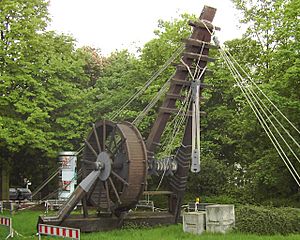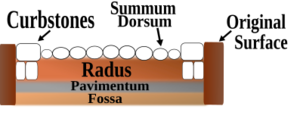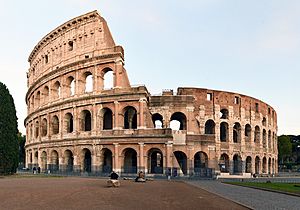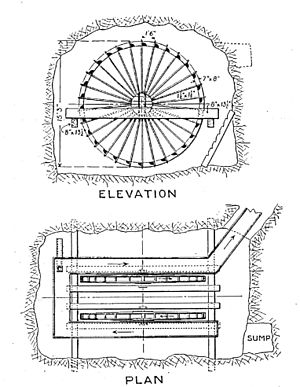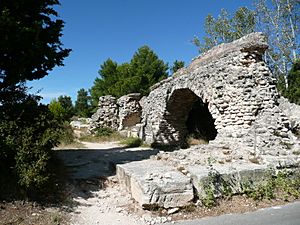Ancient Roman engineering facts for kids
The ancient Romans were amazing engineers. They built incredible structures that are still standing today! They took ideas from the Greeks and Etruscans, but made them even better. For example, they developed ways to bring running water into cities. This was a huge step forward for their time.
Contents
- Roman Roads: Built to Last
- Aqueducts: Bringing Water to Cities
- Bridges: Spanning Rivers and Valleys
- Dams: Controlling Water Flow
- Architecture: Grand and Lasting Buildings
- Materials: What They Built With
- Mining: Getting Resources from the Earth
- Military Engineering: The Army's Builders
- Power Technology: Harnessing Water's Energy
- See also
Roman Roads: Built to Last
Roman roads were built to be super strong. They could handle floods and other bad weather. Some of these roads are still used even now!
Most high-quality Roman roads had five layers. The bottom layer was called the pavimentum. It was about one inch thick and made of mortar.
Above this came the statumen. This layer was one foot thick. It used stones held together with cement or clay.
Next was the rudens, made of ten inches of packed concrete. The nucleus layer followed, with twelve to eighteen inches of rolled concrete.
The top surface was called summa crusta. It used large, flat stones of silex or lava. These stones were one to three feet wide and eight to twelve inches thick. The very top was smooth concrete or fitted flint.
Romans usually built straight roads. If they met an obstacle, they built over or through it. They made bridges over rivers. They built raised paths over marshy ground. They even cut through or tunneled into hills!
Aqueducts: Bringing Water to Cities
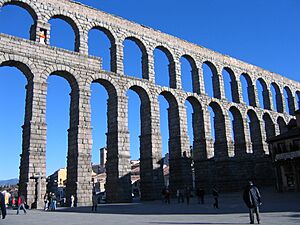
Ancient Rome received a huge amount of water every day. Eleven different aqueducts brought water into the city. This was enough water for public uses, like baths and sewers. People in ancient Rome used as much water per person as people in modern cities like New York!
Aqueducts could be very long, from 10 to 100 kilometers (6 to 62 miles). They usually started high up, around 300 meters (984 feet) above sea level. They ended at reservoirs near the city, about 100 meters (328 feet) high.
Roman engineers used clever methods to move water. They built raised aqueducts to cross valleys. If a valley was too deep, they used "inverted siphons." These pipes carried water down one side of a valley and up the other.
The Roman army helped build many aqueducts. Slaves often did the maintenance work.
The Romans were also experts at using water power. They built some of the first watermills outside of Greece. These mills ground flour. They spread this technology all over the Mediterranean.
A famous example is at Barbegal in southern France. There, 16 watermills were built on a hillside. One aqueduct fed water to the top mill. The water then flowed from one mill to the next, powering them all!
Romans were also skilled miners. They built aqueducts to bring water to mines. This water helped them extract metal ores, like gold. They also built reservoirs to store water for mining. They even had crushing mills and machines to remove water from mines. Large wooden wheels for lifting water have been found in the Rio Tinto mines in Spain.
Bridges: Spanning Rivers and Valleys
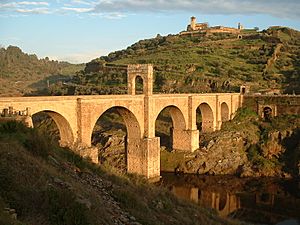
Roman bridges were some of the first large and long-lasting bridges ever built. They were made of stone. The basic structure was the arch, which is very strong. Many bridges also used concrete.
The Pons Aemilius in Rome was built in 142 BC. It is the oldest Roman stone bridge in the city. Today, it's called Ponte Rotto, meaning "broken bridge."
The biggest Roman bridge was Trajan's bridge over the Danube River. It was built by Apollodorus of Damascus. For over a thousand years, it was the longest bridge ever built. Roman bridges were usually at least 18 meters (59 feet) above the water.
A great example of a temporary military bridge is Julius Caesar's bridge over the Rhine River.
Dams: Controlling Water Flow
The Romans built many dams to collect water. The Subiaco Dams in Italy are an example. Two of these dams fed the Anio Novus, which was the largest aqueduct supplying Rome. One Subiaco dam was thought to be the highest ever found from ancient times.
They built 72 dams in Spain, like those near Mérida. Many more dams are known across the Roman Empire. At one site in Spain, Montefurado, they built a dam across the Sil River. This was done to find gold deposits in the riverbed. This site is near the famous Roman gold mine of Las Medulas.
Earthen dams were also found in Britain. One well-preserved dam at Roman Lanchester might have been used for metalworking. Tanks for holding water were common along aqueduct systems. Many examples are known from the gold mines at Dolaucothi in Wales. In North Africa, masonry dams were built to provide water from dry riverbeds (wadi) to settlements.
Architecture: Grand and Lasting Buildings
The buildings of Ancient Rome were truly impressive. The Circus Maximus was a huge stadium for chariot races. The Colosseum is another amazing example of Roman architecture. It shows the arches and curves that were common in Roman buildings.
The Pantheon in Rome is still standing today. It serves as a monument and a tomb. The Baths of Diocletian and the Baths of Caracalla are also well-preserved. The Baths of Diocletian still have their original domes.
These massive public buildings were copied in many cities across the empire. A Roman writer named Vitruvius described their design and construction. He wrote about them in his important book, De architectura.
The Romans also developed impressive technology for their baths. They widely used the hypocaust system. This was one of the first types of central heating ever invented! This invention was used in public baths and also in private homes, like the many villas built across the Empire.
Materials: What They Built With
The Romans mainly used brick, stone, cement, concrete, and marble. Bricks came in many shapes. Curved bricks were used for columns. Triangular bricks were used for walls.
Marble was mostly used for decoration. Emperor Augustus once bragged that he had changed Rome from a city of bricks to a city of marble. At first, Romans brought marble from Greece. Later, they found their own quarries in northern Italy.
Roman cement was made from hydrated lime mixed with sand and water. The Romans discovered that adding volcanic ash made a very strong cement. This was called hydraulic mortar or hydraulic cement. They used it widely in buildings, baths, and aqueducts. This is why so many of their structures have lasted for centuries.
Mining: Getting Resources from the Earth
The Romans were pioneers in mining. They used advanced technology, especially aqueducts. These brought water from far away to help with mining operations. You can see their technology at sites like Dolaucothi in Britain. There, they used at least five long aqueducts to find gold.
They used water to search for ore. They would release a wave of water from a tank to wash away soil. This would reveal the bedrock and any metal veins. They also used this method, called hushing, to remove waste rock. They even used it to cool hot rocks that had been weakened by fire-setting.
These methods were very effective for open-pit mining. Fire-setting was dangerous in underground mines. Today, explosives are used instead. However, hydraulic mining is still used for some tin ores. Water was also used to wash crushed ore and collect gold dust.
At large gold mines like Las Medulas in Spain, they used hydraulic mining on a huge scale. Traces of water tanks and aqueducts can be found at many early Roman mines. Pliny the Elder described these methods in his book, Naturalis Historia. He also wrote about deep underground mining. He mentioned the need to remove water using reverse overshot water-wheels. Actual examples of these wheels have been found in Roman mines. For instance, 16 wheels were found in the copper mines at Rio Tinto in the 1920s. Romans also used Archimedean screws to remove water.
Military Engineering: The Army's Builders
Engineering was a big part of the Roman military. Soldiers built forts, camps, bridges, roads, ramps, fences, and siege equipment. One famous example is Julius Caesar's bridge over the Rhine River. His team of engineers built this bridge in just ten days! Their building skills during the Dacian wars are shown on Trajan's column in Rome.
The army also helped with gold mining. They likely built the many water channels and tanks at the Roman gold mine of Dolaucothi in Wales. This was done soon after they conquered the region in 75 AD.
Power Technology: Harnessing Water's Energy
The Romans developed water wheel technology to a high level. Writers like Vitruvius and Pliny the Elder wrote about it. The largest group of water wheels was at Barbegal, near Arles in France. A channel from the main aqueduct fed this site. It had sixteen separate overshot water wheels arranged in two parallel lines down a hillside. The water flowed from one wheel to the next, powering them all.
At Barbegal, the aqueduct reached a steep hill. It then fed a series of water wheels to power a flourmill. There were two aqueducts that joined just north of the mills. A sluice allowed operators to control the water flow. There are still large stone remains of the water channels and mill foundations. A staircase also goes up the hill where the mills were built. These mills likely worked from the late 1st century to about the late 3rd century. They could produce an estimated 4.5 tons of flour per day. This was enough bread for the 12,500 people living in Arles at that time.
The Hierapolis sawmill was a Roman water-powered stone saw mill in Asia Minor (modern-day Turkey). It dates back to the second half of the 3rd century AD. This sawmill is the earliest known machine to combine a crank with a connecting rod.
The sawmill is shown on a stone carving on the tomb of Marcus Aurelius Ammianos, a local miller. It shows a waterwheel powering two saws. These saws cut rectangular blocks.
Other crank and connecting rod machines have been found from the 6th century AD. These were in water-powered stone sawmills at Gerasa, Jordan, and Ephesus, Turkey. Ancient writings also mention water-powered marble saws in Trier, now Germany. This shows that water power was used in many ways across the Roman Empire.
A group of mills also existed on the Janiculum hill in Rome. They were fed by the Aqua Traiana aqueduct. The Aurelian Walls were built to include these water mills. These mills ground grain for bread flour for the city. The mills were probably built around the same time as the walls, by Emperor Aurelian (who ruled 270–275 AD). The mills got water from an aqueduct that flowed down a steep hill.
This site was similar to Barbegal. However, excavations suggest these mills might have been "undershot" (water flowing under the wheel) rather than "overshot" (water flowing over the wheel). The mills were still in use in 537 AD. At that time, the Goths were attacking Rome and cut off their water supply. But the mills were later repaired. They may have continued to operate until at least the time of Pope Gregory IV (827–844).
Many other Roman mill sites have been found across the Roman Empire. However, many have not yet been fully explored.
See also
- List of Roman watermills
- Roman agriculture
- Roman metallurgy
- Roman mining
- Roman technology


